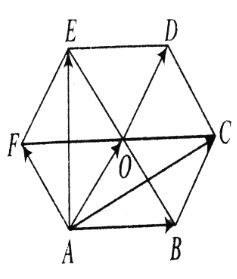Question
Question: ABCDEF is a regular hexagon whose center is O. The \(\overrightarrow{AB}+\overrightarrow{AC}+\overri...
ABCDEF is a regular hexagon whose center is O. The AB+AC+AD+AE+AF is
(a)2AO
(b)3AO
(c)5AO
(d)6AO
Solution
Hint: In the figure below we have a regular hexagon ABCDEF . In this question we can use the concept of addition of vectors using parallelogram law of addition.
Complete step by step answer:

We can regroup these vectors into pairs and then add each pair individually such that we can write the result in terms of AO .
We can rewrite the sum AB+AC+AD+AE+AF by regrouping the terms as given below:
(AB+AF)+(AC+AE)+AD
First we evaluate the sum AB+AF . To evaluate it we first observe that ABOF is parallelogram (more precisely, it is a rhombus). Thus, we can easily see that the resultant vector is AO .
Now we evaluate the sum AC+AE . Since, ABCDEF is regular hexagon we can prove OA=OB=OC=OD=OE=OF and hence ABCO and AFEO are rhombus. This implies that diagonals AC and AE bisect angles OAF and OAB respectively. Therefore,
∠EAD=∠CAD=6π
Thus, ∠EAC=3π
By symmetry we can also prove that ∠AED=∠ACD=6π . Therefore, AE=AC=ADcos6π=3.AO (since, AD=2.AO ).
Since AD is the bisector of ∠EAC we can see that the resultant of AE+AC lies along AO i.e. AO . We can calculate the magnitude of the resultant by using the following formula
